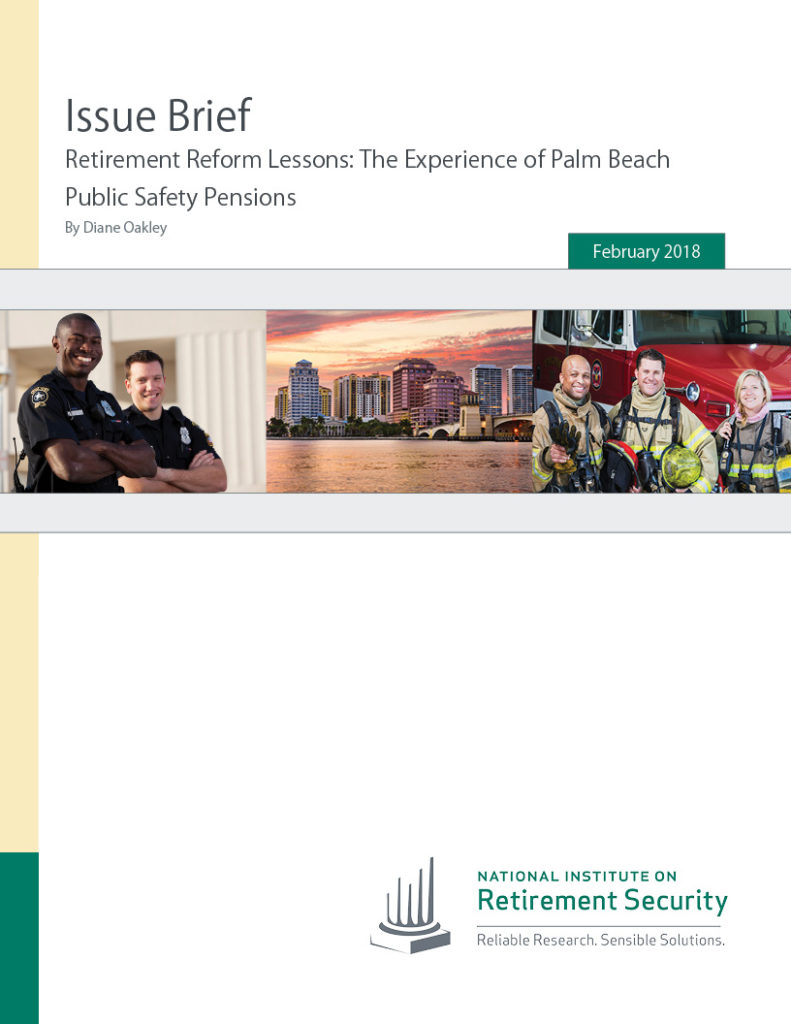
Palm Beach Town Council Reinstated Pension Plan After Unsuccessful and Costly Shift to 401(k) Accounts
Webinar on Thursday, February 15th at 1 PM ET to Review Findings
WASHINGTON, D.C., February 8, 2018 – A new case study examines the impacts of the 2012 actions of the Town of Palm Beach to close its existing defined benefit (DB) pension systems for its employees, including police officers and firefighters.
The new “combined” retirement plans offered dramatically lower DB pension benefits and new individual 401(k)-style defined contribution (DC) retirement accounts. Shortly thereafter, the town experienced a high rate of retirements and unprecedented early departures of experienced police officers and firefighters to neighboring towns that offered better pensions. Now understaffed, the town faced increased costs to pay overtime hours and train replacements for more than 100 public safety workers who departed during a four-year period after the pen sion changes.
sion changes.
Following this large, swift exodus of public safety employees, the town reconsidered the changes. In 2016, the Town Council voted to abandon the DC plans and to improve the pension plan for police officers and firefighters.
These findings are contained in new research case study from the National Institute on Retirement Security (NIRS), Retirement Reform Lessons: The Experience of Palm Beach Public Safety Pensions. The research is authored by Diane Oakley, NIRS executive director.
- Download the case study here.
- Register for the webinar here.
- Watch here a video of a public employee regarding changes to the retirement plan.
“This case study serves as a cautionary tale to public sector employers considering changes to their employee retirement plans,” says Diane Oakley, report author and NIRS executive director. “The town learned the hard way that pension plans – provided to nearly all police officers and firefighters across the country – help keep experienced public safety workers on the job protecting our communities. The Palm Beach saga was a painful and costly lesson that pensions are a critical workforce management tool to recruit, retain and retire public employees,” Oakley said.
Research finds that public workers place a high value on retirement benefits, even more so than private sector works. For public safety workers, pensions are highly valued because they also offer death and disability benefits, and because the risks and physical demands associated with their jobs can shorten their years in the workforce.
“Perhaps the most compelling data point in the case study is that a total of 53 mid-career police officers and firefighters left their jobs before retirement after the Town Council voted to change the pension plan,” Oakley explained. “Previously, just two mid-career public safety workers left their jobs before reaching retirement. Faced with unprecedented departures and large overtime and training costs, the town moved to unscramble the egg and restore the pension plan,” Oakley said.
This case study supplements past NIRS research examining retirement plans in Alaska, Michigan and West Virginia where a shift from DB pensions to 401(k)-style individual accounts caused pension plan costs to skyrocket. The new case study also can be considered alongside recent NIRS research that examines the employee recruitment and retention impacts of pensions.
The case study finds that pensions:
- Dismantling the DB pension benefit caused a mass exodus of public safety officers. Employees’ reactions to losing their expected DB pension benefits were swift. The town’s two public safety pensions covered 120 employees at the end of 2011. In addition to 20 percent of the town’s workforce retiring after the change, 109 other protective officers left before retirement in the next four years. Mid-career public safety officers departed in unprecedented numbers, with 53 vested police officers and firefighters departing Palm Beach’s forces from 2012 to 2015. By comparison, just two mid-career employees departed from 2008 to 2011.
- Neighboring towns benefited from the changes that Palm Beach implemented to its retirement plans. Nearby towns watched the controversy erupt in Palm Beach, and decided to adjust their pensions rather than dismantle this employees benefit. The 109 trained officers who decided to leave Palm Beach provided a talent pool for other towns and counties. For example, in the next four years, 31 newly-hired Palm Beach firefighters left with a refund of their pension contributions and seemed to jump at the chance for a DB pension offered by a nearby town. Previously, only three firefighters took refunds in the four years before the pension freeze.
- The shift away from the DB pension increased costs in other areas. The town did not anticipate the financial impact of the high attrition. For example, firefighters had to work extremely high levels of overtime to fill staffing gaps. Also, the unprecedented loss of new and experienced public safety officers caused the town’s training cost to soar likely reaching upwards of $20 million, based on an “all in” cost estimate of $240,000 per officer to bring a new police officer through the rookie period in Florida.
- The DC switch proved a failed experiment in Palm Beach. The Town Council voted in 2016 to abandon the DC plans and improve the DB pensions for police officers and firefighters by raising benefits substantially and lowering the retirement age. The Council offset the cost of the police and fire DB pension improvements by increasing employee contributions and eliminating the DC plan with its employer match.
The National Institute on Retirement Security is a non-profit, non-partisan organization established to contribute to informed policymaking by fostering a deep understanding of the value of retirement security to employees, employers and the economy as a whole. Located in Washington, D.C., NIRS’ diverse membership includes financial services firms, employee benefit plans, trade associations, and other retirement service providers. More information is available at www.nirsonline.org. Follow NIRS on Twitter @nirsonline.
##